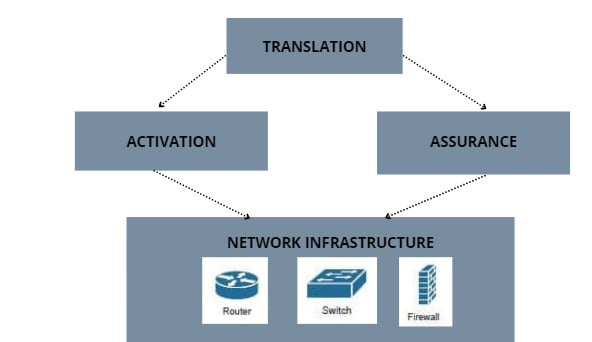Software-Defined Networking is a technology that uses automation to dynamically apply changes on the network with the help of an SDN controller, which acts as a centralized brain of the network. For SDN controller to apply automation to the network, it uses the technology of Intent-Based Networking System.
What is Intent-Based Networking (IBN)?
Intent-Based Networking (IBN) is a technology concept that aims to apply a deeper level of intelligence and replace the manual processes of network configuration and reacting to network issues. It allows all manual and hardware-related tasks and operations to be replaced into a fully automated implementation or software-based system.
With IBN, there is no need to do a box-by-box configuration by logging in to each router and switch individually. There is no need to configure the EIGRP/OSPF routing protocol or Access Control Lists manually (to deny or allow traffic) on a group of routers. With the help of IBN, the configurations will apply automatically to all the groups of the network devices based on our intent on how we want the network to operate. SDN controllers like Cisco DNA Center uses Intent-Based Networking systems.
Intent-Based Networking Functions
Below are the functions of Intent-Based Networking (IBN):
1. Translation
This function gathers information about the business intent or requirement and translates it by creating policies. The network administrators will analyze and elaborate the business needs, tell on Cisco DNA Center, and Cisco DNA Center will translate that into policies that will be implemented on the network.
2. Activation
This function correlates the policies it received from the Translation Function, then it on the network devices such as routers, switches, and firewall to meet the intent of the business or organization.
3. Assurance
This function continuously gathers all the insights and information about the enterprise networks for Cisco DNA Center to perform adjustments to the network in the future.
The below image shows the three functions in Cisco DNA infrastructure:
Fabric is a term used in Intent-Based Networking for the network infrastructure, including both physical and virtual network devices. It is used to describe the whole network topology, such as network devices and applications.
How Does IBN Works?
To better understand the concepts of IBN, we will apply the three functions mentioned above and compare them with the traditional way of handling the network.
What is the Intent or Requirement of the Organization?
The organization wants to have a guaranteed bandwidth for its voice and video traffic.
Using the Traditional Way of Networking
The network team configures QoS on every network device, such as routers and switches, ensuring that the voice and video traffic will have guaranteed traffic. A different model of network devices requires a different set of commands/syntax; thus, this method is time-consuming and prone to configuration mistakes.
Using Intent-Based Networking
The network administrator gathers all the requirements needed and will tell the Cisco DNA Center specifying to have a guaranteed bandwidth in the voice and video. Cisco DNA Center will automatically create and configure a policy for the best practice QoS settings on the network devices. This implementation can reduce the total deployment of the organization’s intent to their network.
Download our Free CCNA Study Guide PDF for complete notes on all the CCNA 200-301 exam topics in one book.
We recommend the Cisco CCNA Gold Bootcamp as your main CCNA training course. It’s the highest rated Cisco course online with an average rating of 4.8 from over 30,000 public reviews and is the gold standard in CCNA training:

